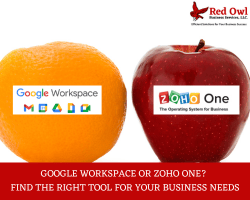
Introduction
Introduction
In the digital age, efficient data storage and seamless document creation are pivotal for business productivity. Two great solutions in this space are Google Workspace (affiliate link) and Zoho One (affiliate link) . Both platforms offer a robust suite of tools, but they cater to different needs and preferences. Here's an expert comparison to help you decide which might be best for your business.
Google Workspace
Google Workspace, formerly known as G Suite, is a cloud-based productivity suite that integrates Google's core services like Gmail, Google Drive, Google Docs, Sheets, Slides, and more. It’s designed to foster collaboration and improve business efficiency. When I started my business back in 2020, after getting laid off from my last corporate job due to the pandemic, I dove into learning Google Workspace. It was inexpensive, I already knew how to use the apps it contained, and at the time, Google was the only other suite of this type that I knew of besides Microsoft365. Microsoft365 was a LOT more expensive at the time, so this seemed like a no-brainer.
Top 3 Pros:
- Seamless Collaboration: Google Workspace excels in real-time collaboration. Multiple users can work on the same document simultaneously, see edits in real time, and communicate through integrated chat features.
- Integration with Third-Party Apps: Google Workspace integrates effortlessly with numerous third-party applications, enhancing its functionality and flexibility. Where Zoho One includes many applications that integrate with each other, Google Workspace integrates with existing applications rather than creating them within the Google Workspace Environment.
- Wide Adoption and Familiarity: Most users are already familiar with Google’s interface, making the transition smoother and minimizing the learning curve. This widespread familiarity means that employees can quickly adapt to using the tools without extensive training, thereby reducing downtime and increasing productivity from the outset.
Top 3 Cons:
- Cost: While Google Workspace offers a range of pricing plans, it can be more expensive compared to other solutions, especially for larger teams. This suite is good for basic document creation and storage, but the number of applications is limited to document creation and basic communication.
- Limited Customization: While Google Workspace provides a range of useful tools and settings, it falls short in offering deep customization options. Businesses with very specific needs or those requiring unique workflows may find the platform somewhat rigid. The customization constraints can limit the ability to tailor the workspace to fit particular operational requirements, potentially leading to inefficiencies or the need for additional tools to fill gaps.
- Data Privacy Concerns: Given Google's business model, which heavily relies on data-driven advertising, some users express concerns about data privacy and how their information is used. Although Google Workspace for business customers operates under stricter privacy policies than free consumer services, the overarching concerns about data collection and potential usage can be a significant consideration for businesses handling sensitive information or those prioritizing privacy. This apprehension might influence the decision-making process for companies where data confidentiality is paramount.
Zoho One
Zoho One is an all-in-one suite that includes over 40 integrated applications designed to manage, automate, and connect various business processes. From CRM and project management to invoicing and email hosting, Zoho One offers a comprehensive solution. This includes applications similar to Drive (WorkDrive), Docs (Writer), Sheets (Sheet), and Slides (Show) in the Google Workspace Platform. I learned about this suite of applications from two business coaches I had and was quite impressed with the total array of applications they have. As a one-woman business, their $45/user/month price tag made sense. Now that my business is starting to grow, it still makes sense because of the number of useful tools I can employ and integrate to develop systems within my business environment.
Top 3 Pros:
- Comprehensive Suite: Zoho One offers an extensive array of applications that cover nearly every aspect of business management, including CRM, project management, finance, HR, and marketing. This makes it a true one-stop solution for businesses looking to consolidate their software needs under a single platform. The integration between these applications ensures a cohesive experience, reducing the need for multiple disparate systems, multiple subscription fees, and enabling smoother, more efficient workflows across the organization.
- Cost-Effective: Zoho One is known for its affordability, especially when compared to Google Workspace. It provides a broad spectrum of tools at a lower price point, making it an attractive option for small to medium-sized businesses and startups that need robust functionality without breaking the bank. The all-inclusive pricing model eliminates the need for additional software purchases, offering significant cost savings over time and making advanced business tools accessible to companies with limited budgets.
- Customization and Flexibility: Zoho One stands out with its extensive customization options, allowing businesses to tailor the platform to their specific needs and workflows. Users can customize dashboards, create custom applications, and configure workflows to align with their unique processes. This flexibility ensures that businesses can adapt the software to fit their precise requirements, enhancing efficiency and productivity by providing a solution that truly matches their operational style and goals.
Top 3 Cons:
- Complexity: With an extensive range of applications available, Zoho One can be overwhelming for new users or smaller businesses with simpler needs. The sheer number of features and options might require a steeper learning curve and more time to master, potentially leading to initial inefficiencies. For businesses that do not require such comprehensive tools, the platform’s complexity can feel like overkill, necessitating extra effort to navigate and utilize effectively.
- Integration Issues: While Zoho One offers numerous applications, integration between them can sometimes be less seamless than desired. Users might encounter occasional synchronization problems or inconsistencies in data flow, which can lead to inefficiencies and frustration. These integration challenges can necessitate additional troubleshooting or reliance on external tools to bridge gaps, detracting from the platform’s overall usability and convenience.
- User Interface: The user interface of Zoho One can feel less intuitive compared to Google Workspace, requiring more time for users to get accustomed to its features. The design and layout may not be as user-friendly, leading to potential difficulties in navigation and task execution. This can be particularly challenging for teams transitioning from more straightforward systems, necessitating additional training and adjustment periods to fully leverage the platform’s capabilities.

